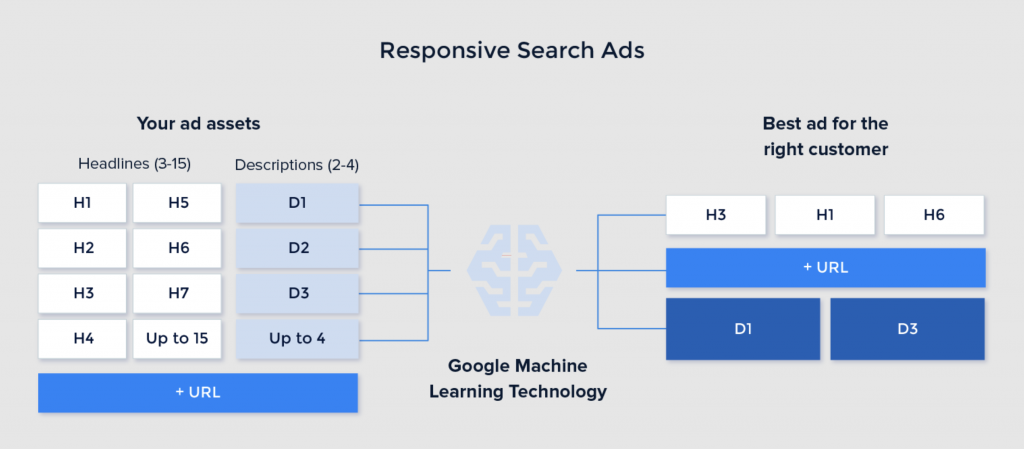Move over, expanded text ads, and make way for RSAs.
Here, you’ll find:
- How to define RSAs
- How these ads factor into a digital marketing program
- The benefits of RSAs
- A helpful responsive search ad checklist
Google announced that it would be phasing out expanded text ads (ETAs) and solely using responsive search ads (RSAs) going forward as of June 2022. Existing ETAs can still be paused and resumed, but new ones can’t be created.
(Microsoft Advertising announced that they’ll also be sunsetting ETAs two months later, at the end of August 2022.)
Responsive search ads have revolutionized how marketers create and use search ads and the interaction they get from those searching online.
Not sure what this change means or just want more details? Let’s dive into what RSAs are and how they affect you and your digital ad strategy, with help from our Lead Strategist Rachel Corak.

A visual look at how RSAs work. (Image: Instapage)
What are RSAs in marketing?
Responsive search ads are a dynamic text ad type. Unlike static pay-per-click (or PPC) ads, these dynamic ads allow for multiple variations of headlines and descriptions.
These ads will show different results on the search engine results page (SERP) based on a searcher’s query.
Rachel explains that, while marketers have less control over which ad combinations are specifically served within the RSA, they have more opportunities to write relevant ad copy. A responsive search ad can include up to 15 headline options (up to 30 characters each) and four descriptions (up to 90 characters each).
Based on the search query, Google dynamically pairs different combinations of headlines and descriptions to optimize the ad while increasing relevance and click-through rate (CTR).
Pro tip: Search Engine Land notes that, while RSAs are graded by strength, the grade won’t affect an ad’s Quality Score. “Ad strength is based on increasing RSA CTR and providing fruitful information for Google bots to chew on,” SEJ explains. “It’s a guideline and does not relate to actual ad performance.”
How RSAs factor into a digital marketing program
A search ad campaign’s purpose is to allow your brand to be visible for relevant search queries at the exact moment someone is seeking information.
Ultimately, says Rachel, the intention is to garner traffic to your site.
With RSAs now being the only option within search ad formats, they’re a necessity for advertisers who want to run search campaigns. This makes them an essential element of a digital marketing program.
Whether your brand chooses to run search campaigns as a means of increasing your conversion rate, capturing branded traffic to stay competitive, or attracting upper funnel leads (targeting potential customers in the exploratory stages), responsive search ads allow you to match the proper ads with the proper search queries.
Pro tip: According to Google, existing ad customizers for expanded text ads will continue to serve only until December 31, 2022.

An example of an expanded text ad. (Image: Google)
The benefits of RSAs
Responsive search ads are not new in the Google ads space. However, some advertisers have hesitated to use them, preferring the benefits of expanded text ads (AKA, more control over ad copy).
Sure, RSAs provide less control than ETAs. But there are huge benefits to implementing them, beyond the fact they’re now a requirement.
Here are some ways they can help you and your marketing strategy:
- More headlines and descriptions than traditional text ads
- Increased CTR due to being able to create more relevant ad copy
- Less time-consuming than writing dozens of expanded text ads
- Machine learning helps you find the best performing ad copy without requiring the same level of data analysis
Rachel adds that it’s worth noting you do have the option to pin specific headlines and descriptions within RSAs to achieve a similar experience to ETAs.
That said, pinning different headlines and descriptions can negatively impact ad strength with RSAs. It does provide flexibility if you’re seeking more control over ad copy and the order of the text.
How to transition to RSAs from ETAs
Migrating from expanded text ads to responsive search ads may require a bit of trial and error. While each of these ad types have (or had) their own strengths), there are plenty of things you can do to ensure you’re setting up your RSAs for success.
Taking ample time to craft your headlines and descriptions is one of the most important things you can do when it comes to RSAs. Make the effort to conduct your research, check out what competitors are doing, and be strategic about keyword usage.
Keep your audience and value propositions in mind — this will help ensure your ad copy is targeted, actionable, and direct.
It’s also worth noting that, as always, you can take Google’s suggestions with a grain of salt. They may suggest headlines that simply won’t work for your brand for one reason or another. Trust your gut.
Google Ads RSA checklist
If responsive search ads are a new ad type for you, this convenient checklist can help guide you. Keep these in mind when you build RSAs to maintain excellent ad strength, keep CTR high, and drive plenty of traffic to your site:
- Ensure you have at least one RSA in each ad group
- Complete all 15 headlines and all 4 descriptions
- Avoid pinning headlines and descriptions
- Write unique headlines and descriptions
- Use call-to-action messaging in your ads
- Focus on value and unique selling points
- Write headlines and descriptions that include keywords within your ad group
Pro tip: Google suggests including at least three popular keywords in your headline.
The takeaway
Google’s responsive search ads are now the primary text ad format. They’re a requirement if you’re looking to build effective Google search ads.
While RSAs allow for a bit less control than expanded text ads did, they offer a lot of benefits and create more opportunity to increase CTR.
By implementing them properly and following best practices, you’ll be ready to launch high-quality ads and garner more traffic to your website. Win-win.

